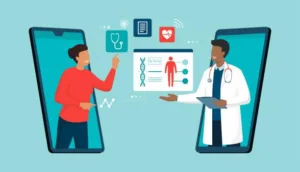In an era when cutting-edge technology is transforming almost every aspect of human existence, healthcare organizations and professionals need software tools that simplify treatment delivery, expedite routines, and ultimately improve patient outcomes.
Efficiency is one of the factors becoming increasingly important in the healthcare industry. Problems with technological advancement are greater than they have ever been. Consumers expect responsibility and proof. Consequently, agencies, such as Healthcare App Development Company—Langate, are advancing toward a patient-centered strategy to change patient care and experience.
What is Software Development for Healthcare?
The development of software for the healthcare sector is crucial. It aids medical professionals in giving their patients better, more efficient care. They may benefit from healthcare software firms’ software in several ways. They may exchange and keep track of their clinical records with other physicians with their assistance. Thanks to the program, they may also better plan their patients’ treatments by keeping track of their medical histories.
The healthcare sector also uses this software to facilitate departmental communication inside a single hospital or clinic. This enables the exchange of case information and patient data, which is helpful in providing patients with the proper care.
A Synopsis of the Medical Field
The healthcare sector is among the largest sectors of the global economy. The global healthcare industry is now valued at a whopping $7.975 billion, and by 2027, it is projected to reach $9.816 billion. The healthcare market includes all businesses that provide clinical services, assistance for health issues, and the creation of medications and medical devices.
Pros and Cons of Custom Healthcare Software Development:
Custom healthcare software offers the ability to build specialized digital health tools tailored to specific organizational or user needs. However, these customized systems require more effort, expertise, and investment than off-the-shelf solutions.
Pros:
personalized features and workflows to enhance patient care, clinician productivity, and operational efficiency;
integration with existing healthcare IT ecosystems, including electronic health records and medical devices;
configurable around customized clinical workflows and specialized settings;
competitive advantages and ownership through proprietary health IT IP;
scales capabilities in step with emerging trends and regulations;
enables advanced data interoperability, analytics, and insights.
Cons:
lengthy development cycles spanning months or years;
complex custom-coded solutions become increasingly difficult to upgrade and maintain;
tight coupling within specialized systems risks limiting long-term flexibility;
achieving a return on investment depends heavily on driving user adoption and alignment to workflows;
insufficient budgets risk incomplete or poor-quality software.
Weighing the tradeoffs allows for selecting appropriate solutions to balance customization and simplicity while serving the most critical needs.
How Can Custom Healthcare Software Be Developed?
Developing software requires careful analysis, planning, and execution across critical phases from conception to deployment. Even if you use a custom hospital software development company, it is still essential for you to know the process.
Define Goals and Requirements
Start by clearly defining the vision and goals for the software based on patient, provider, or healthcare business needs. Profile end users and use cases to itemize detailed functionality requirements. Prioritize must-have vs nice-to-have features. Outline compliance needs around healthcare data security and privacy regulations.
Choose Technology Architecture
Select optimal development frameworks and tools based on requirements and use case constraints around performance, scalability, and maintenance. Standard healthcare software technology stacks include .NET, Java/J2EE, PHP/Laravel, Ruby on Rails, Python, and JavaScript. Define needed integrations with EHRs, healthcare databases, payment systems, etc.
Model and Design Software
Create conceptual data and system architecture models aligned to specifications. Produce UI/UX workflows, wireframes, and visual designs optimized for the target user base. Incorporate stakeholder feedback into iterative design updates.
Develop and Program
MAP designs into functional software with coding best practices for performance, security, and compliance. Build reusable components for efficiency. Integrate APIs and frameworks for prescription handling, insurance claims, and scheduling. Implement DevOps tools to enable continuous updates.
Systematically Test
Rigorously test software for functionality, interoperability, security vulnerabilities, and performance under load. Perform unit, integration, system, regression, and user acceptance testing. Fix bugs and retest until all requirements are met.
Deploy and Monitor
Once thoroughly validated, deploy the solution into production healthcare IT environments. Proactively monitor system health. Gather user feedback. Measure adoption and set benchmarks for success.
Maintain and Update
Enable rapid responses to emerging operational issues. Regularly patch, upgrade, and optimize the system. Add new supported technologies. Continually enhance features based on usage data and healthcare sector evolution—account for changing regulations.
I am following these phases diligently while collaborating across technical and healthcare domain experts.
Bottom Line
Any effective healthcare software solution must start with a thorough knowledge of the demands of the target audience to design a solution that can satisfy them all. The goal of developing such software is to enhance the healthcare system and make patients’ lives simpler. One might say that using software in hospitals is practically required.
Also Read:
What is Genomics? How Has It Impacted the Healthcare Sector?
Innovative Technologies Shaping the Future of the Medical Device Industry


